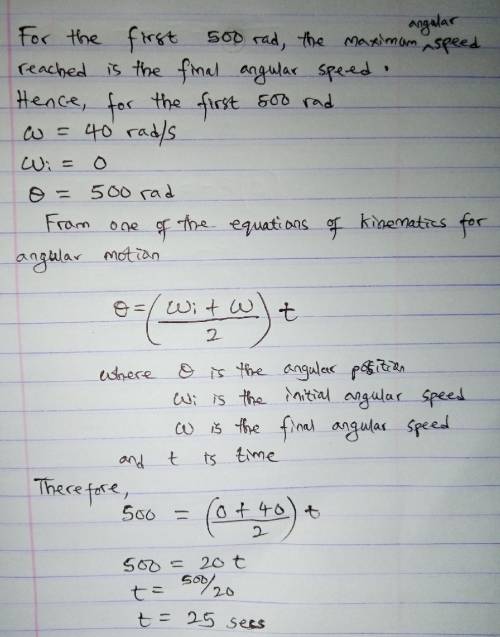
Physics, 15.04.2020 04:40 telonfrippp5i9i5
A disk, with a radius of 0.25 m, is to be rotated like a merry-go-round through 1000 rad, starting from rest, gaining angular speed at the constant rate through the first 500 rad and then losing angular speed at the constant rate until it is again at rest. The magnitude of the centripetal acceleration of any portion of the disk is not to exceed 400 m/s².
(a) What is the least time required for the rotation?
(b) What is the corresponding value of α₁?

Answers: 1
Another question on Physics

Physics, 22.06.2019 01:00
First, launch the video below. you will be asked to use your knowledge of physics to predict the outcome of an experiment. then, close the video window and answer the question at right. you can watch the video again at any point. part a as in the video, we apply a charge +q to the half-shell that carries the electroscope. this time, we also apply a charge –q to the other half-shell. when we bring the two halves together, we observe that the electroscope discharges, just as in the video. what does the electroscope needle do when you separate the two half-shells again? view available hint(s) as in the video, we apply a charge + to the half-shell that carries the electroscope. this time, we also apply a charge – to the other half-shell. when we bring the two halves together, we observe that the electroscope discharges, just as in the video. what does the electroscope needle do when you separate the two half-shells again? it deflects more than it did at the end of the video. it deflects the same amount as at end of the video. it does not deflect at all. it deflects less than it did at the end of the video. submit
Answers: 2

Physics, 22.06.2019 02:50
Ammonia enters the expansion valve of a refrigeration system at a pressure of 10 bar and a temperature of 18oc and exits at 6.0 bar. the refrigerant undergoes a throttling process. determine the temperature, in oc, and the quality of the refrigerant at the exit of the expansion valve.
Answers: 3

Physics, 22.06.2019 03:00
Isla’s change in velocity is 30 m/s, and hazel has the same change in velocity. which best explains why they would have different accelerations? isla had negative acceleration, and hazel had positive. isla had a different time than hazel. isla had positive acceleration, and hazel had negative. isla went a farther distance than hazel.
Answers: 1

Physics, 22.06.2019 11:20
If a rock is thrown upward on the planet mars with a velocity of 12 m/s, its height (in meters) after t seconds is given by h = 12t − 1.86t2. (a) find the velocity of the rock after two seconds. m/s (b) find the velocity of the rock when t = a. 12−3.72a m/s (c) when will the rock hit the surface? (round your answer to one decimal place.) t = s (d) with what velocity will the rock hit the surface? m/s
Answers: 1
You know the right answer?
A disk, with a radius of 0.25 m, is to be rotated like a merry-go-round through 1000 rad, starting f...
Questions

English, 12.12.2020 20:00





Mathematics, 12.12.2020 20:00


Mathematics, 12.12.2020 20:00

Mathematics, 12.12.2020 20:00





Mathematics, 12.12.2020 20:00



Geography, 12.12.2020 20:00


History, 12.12.2020 20:00

Social Studies, 12.12.2020 20:00






